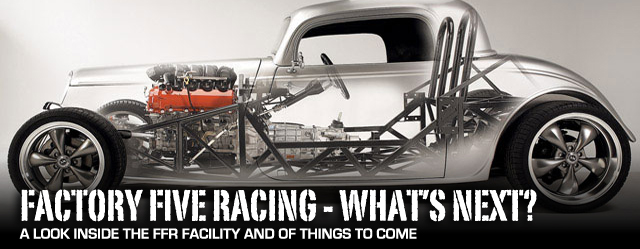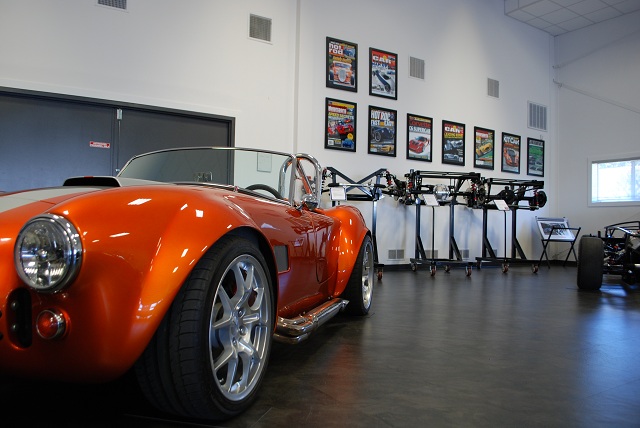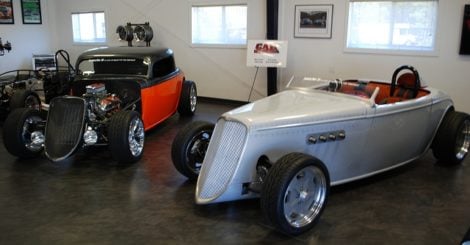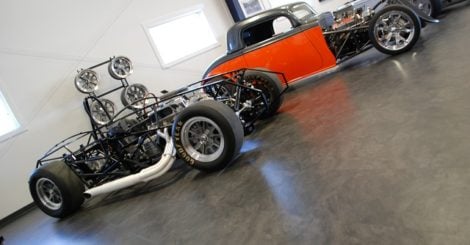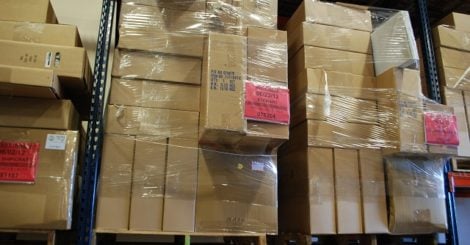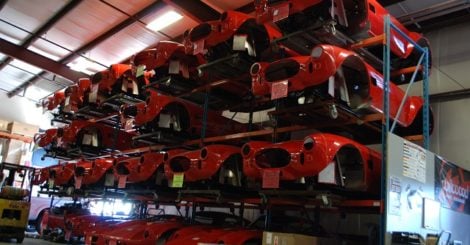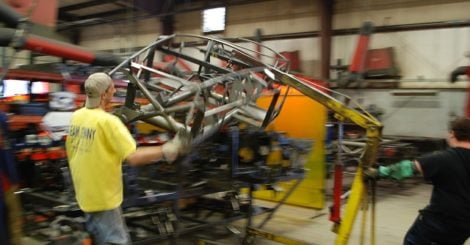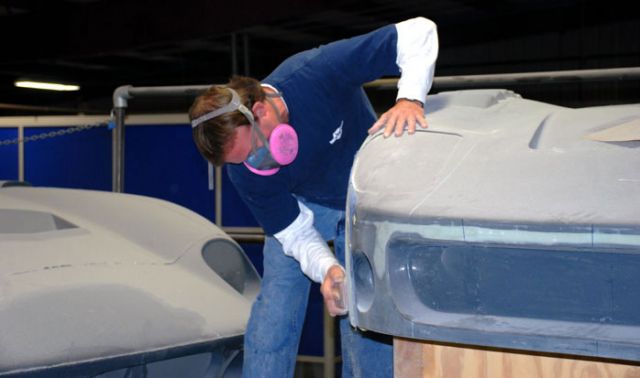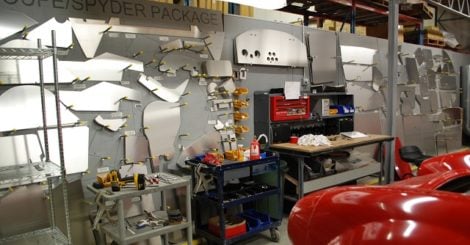“Kit Cars” in the 1970s implied something almost childish, a less-than serious toy. And rightfully so, the term was appropriate for the flood of poorly-made kit cars “inspired” by famous (and expensive) supercars like the Shelby Cobra. That is, not until Factory Five Racing [2] came along in 1995.
Driven by the passion of Dave Smith, a survivor of the corporate world who wanted to build a different kind of company, Factory Five Racing has come to epitomize some of the very best that kit cars have to offer. Their emphasis on not just performance, but on value and customer service has thrust them to the forefront of the modern kit car movement. So this month we set out and toured the Wareham, Massachusetts-based factory to bring you the inside scoop.
A Fully-Assembled Showroom
Jason Lavigne was on hand to give us the full tour, which started off in the Factory Five Showroom. There, all of FFR’s models were represented, including four generations of the Factory Five Roadster [4], their most famous and popular model. “The original Roadster was an excellent car, but we feel there is always room for improvement,” explains Lavigne.
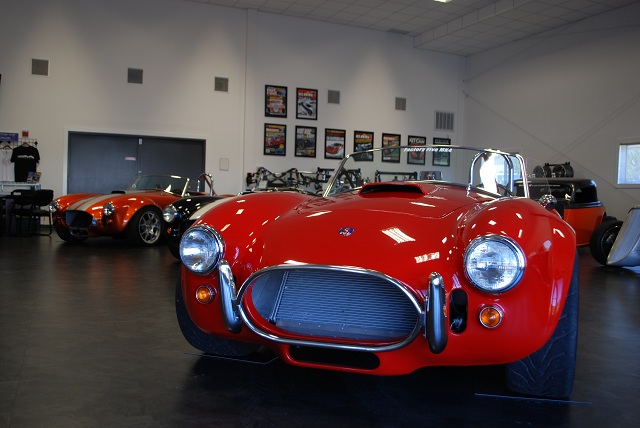 [5]
[5]In the foreground is the most recent model of Factory Five's Roadster, the Mk IV. The orange car behind it is an original Mk I model.
“That is why we are in our fourth generation since the original roadster debuted in 1995,” says Lavigne. “The original idea was to provide a complete body and then use a widely-available donor car, in the Mk 1’s case, the 1987-1993 Ford Mustang, as the source vehicle for many parts. This included the engine, transmission, and suspension.”
Continuing, Lavigne mentioned, “Meanwhile, we could focus on providing top-quality frame and body parts which worked great for awhile. But as the market evolved, so did our cars.” So a few of the second generation Mk II Roadster changes included widening the year range to accept donor parts from 1987-1995 Mustangs, and also FFR removed the trunk “hoop” that was in the original Roadster.
However, by the time 2003 rolled around, FFR was ready to upgrade the Roadster chassis with some more modern improvements. The Mk III Roadster was one of the biggest evolutions, as FFR expanded the donor lineup to include all Mustangs made between 1987 and 2004. Other major performance enhancements included a stronger frame that is easier to work on, tow hooks, a new steering rack location, and plenty of other minor improvements, which all added to a greater performing and reliable build.
Meanwhile, we could focus on providing top-quality frame and body parts which worked great for awhile. But as the market evolved, so did our cars.
FFR even enlarged the foot boxes for both the driver and passenger’s side, making for a more comfortable riding position. “These changes have kept us competitive,” explains Lavgine. “We’re not just resting on our laurels here; we really want to offer customers the best product we can, and as technology and design evolves, so must our products.”
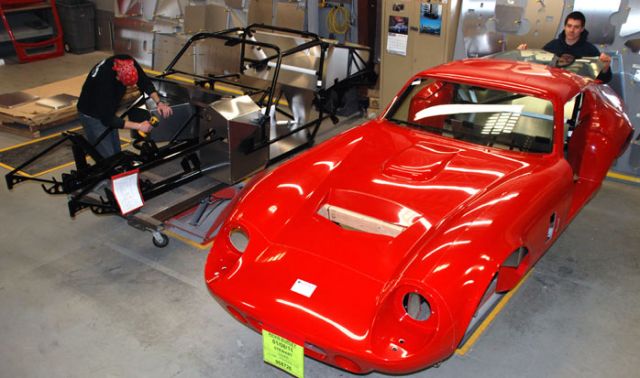 [6]
[6]It takes a lot of hard work to build these top-tier kit cars, but the end product is unlike any other.
A Hot Rod Kit Car Like No Other
Those revolutionary products include more than just vintage Cobra kit cars. Of particular interest to our readers are the ‘33 Hot Rod kits [7] – stay tuned for a full feature story on tips and tricks on assembling the ’33 kits. FFR introduced the ’33 model line-up back at SEMA 2008, where it won Best Hot Rod and runner-up for Best Engineered Product.
That was definitely a big deal a few years back, although it almost didn’t happen at all. As FFR President Dave Smith openly admits, he once said he would never build a hot rod. Why? Because FFR’s focus was on combining old school looks with modern performance – where as most hot rods on the show circuit were show cars without much modern performance. Or as they say, “All show and NO go.”
FFR’s focus was on combining old school looks with modern performance – where as most hot rods on the show circuit were show cars without a lick of performance.
The Factory Five Hot Rod has become not just any old kit car, but the best of both worlds out on the track and in the show circuit. This has quickly become one of their most popular options and is currently used by many high-end hot rod shops when starting their own show-and-go car builds, keeping the philosophy of Factory Five Racing alive.
These two hot rods were built by competing teams for the show Car Warriors. You can also see the frame that underpins both rides.
As with all of their products, Factory Five offers several different packages to go along with your kit car. While at its heart, these projects are designed to borrow from donor cars, FFR knows that some people would rather opt for brand-new, high-quality components. The Stage 1 kit will include all of the chassis and suspension components you’d otherwise have to source. Stage 2 includes interior trim, seats, etc. and you can even order a complete kit [10] and choose all your options.
A Loyal, Diverse, And Vocal Fan Community
Again, base kits remain popular with Hot Rod fans, as everybody has their own interpretation and ideas on what makes the “perfect” rod. To highlight that, Factory Five Racing actually had two completed Hot Rods in its showroom that were on a recent episode of Car Warriors, one a coupe with the optional hardtop, the other an open-air roadster. These are easily some of the most customizable kit cars that have ever been on the market, and it all happened right about the same time when both FFR and the rest of the custom car community needed a lift.
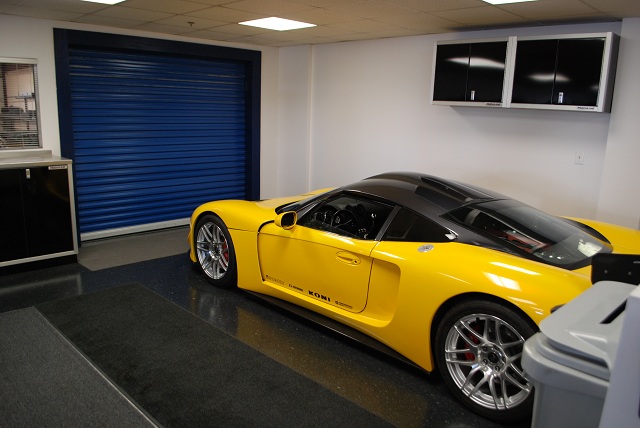 [11]
[11]Instead of a corner office, Factory Five has a Mk II GTM supercar taking up space in the main work area. We can dig it.
Two other models, the Factory Five GTM [12] and the Type 65 Coupe [13], have also found a close and devoted following. The GTM, now in its second generation, utilizes a C5 Corvette as a donor. However, raher than following the traditional front-engine/rear drive setup, Factory Five decided to mid-mount the LS motors, giving better balance and performance to a unique looking car. From one generation to the next, FFR designers smoothed out the GTM’s looks and design, including the vents and unique window design.
These changes came largely based from commentary received from the Factory Five fan community, arguably FFR’s greatest competitive advantage. Factory Five kit owners are loyal and loud, often suggesting ways to improve the next design in a forum dedicated to their specific hobby. “We have a very tight-knit community that is an incredible asset to us,” Lavigne shared. “It’s a constant flow of information coming in from customers so we are constantly bettering our products via direct feedback.”
All Under One Roof
As we continued on to the back offices where sales people mingle with office managers we noticed something strange. It’s not your typical closed offices, and cramped cube farm typical of most companies. In fact, it’s quite the opposite with a very open space designed to promote communication and camaraderie, and as we walked through everybody gave us a warm welcome and greeting as we continued on toward the warehouse/factory floor.
Theses stacks of bodies and boxes will soon be shipped out to customers all over the world.
The first sight we came upon when walking into the warehouse was literally dozens of completed kits waiting to be shipped out. Every car FFR makes is represented on the packed stacks, though the Roadster is by far the most prevalent. Stacked to the ceiling, a quick look at their destination placards reveals the international appeal of Factory Five’s kit cars. “This one is going to Turkey, and this one is going to Australia,” Lavigne shares with us. It’s an impressive display of soon-to-be-completed cars that peaks our interest as to what plans the future owners have in store.
Chassis Fabrication
From there we move into the main assembly area, where a team of skilled welders assemble the various tube-frame chassis underpinning all of FFR’s vehicles. The welders use specially-engineered jigs to ensure tight tolerances and flawless welds.
These guys can crank out anywhere from ten to twelve complete chassis per week, and they don’t mess around. The work is hard, but there is something special about seeing the fruits of your labor turn from a mess of tubular metal into a beautifully-designed performance machine.
In the shop, skilled teams of welders put together individual components on specially-made jigs, eventually chruning out the bare frames of future kit cars
Body Molding
The next stop on our tour is the fiberglass/resin room. This is where dozens of different molds lie in different states of completion. Factory Five recently moved all of its fiberglass production in-house, allowing them to cut manufacturing costs and raise QC to deliver a consistent product every time. This shaves time off of delivery as well, and judging from the various body components lying around the room, their resident fiberglass applier is being kept quite busy.
Sharing a room with the fiberglass layer is perhaps the most impressive machine on site, a CNC fiberglass shaver. “This allows us to deliver pinpoint accuracy for every body-panel, every time,” explains Lavigne. Quite simply, the machine takes the unfinished but hardened resin components, and shaves off all of the excess fiberglass, ensuring a snug fit with every other component. It is something that no human could do with the same accuracy all day, every day.
Fitting Department
Finally, we move into the fitting room, where the fiberglass body components, tubular steel frame, and laser-cut aluminum all come together to create the performance machine each customer is waiting anxiously for. Here, Factory Five engineers assemble the chassis components, bending and forming the aluminum to fit into places like the footbox, trunk, and other areas. FFR does this on every vehicle it sells, shaving many hours (or even years?) off of the time it would take for a home mechanic to figure all this out and bend it to shape. It really does streamlines the whole process.
The completed chassis and all its components are then rolled over to the warehouse section of the shop to await delivery. And if you were an average joe off the street this is probably where the tour would end. However, Jason had one more thing to show us in Factory Five’s R&D department. He gave us a sneak peak and behind-the-scenes look at the next generation of Factory Five vehicles, Project 818.
Finally, it is time for assembly, where laser-cut aluminum meets the hand-laid fiberglass bodies and tubular steel chassis.
Project 818: A Preview Of Things To Come
Project 818 is set to debut at SEMA in November, and represents a marked departure from previous FFR projects.
Lavigne explained the thought process behind this new model. “We want to reach new markets, both outside of the U.S. and our target age demographic.” The Subaru WRX is sold in many more countries than the Ford Mustang, the primary donor vehicle for most FFR vehicles save the GTM. Furthermore, the Subaru WRX appeals to a younger generation of automotive enthusiasts and those who may find the idea of a forced-induction Boxer engine more appealing than a large-displacement V8.”
Project 818 will be a lightweight, mid-engine roadster using a Subaru WRX as its donor car.
In order to thrive FFR must always think outside the box and innovate to stay ahead of the curve and continue to bring new products to new markets. It’s a calculated risk, one that plays on Factory Five’s historical strengths; offering performance-focused kit cars utilizing readily-available donor cars. The two-seat, mid-engine setup combined with a weight of around 1,800 pounds means that Project 818 will be capable of some incredible levels of performance, perhaps besting even FRR’s own Mk IV Roadster model.
Factory Five Racing rocked the kit car industry when it first arrived on the scene in 1995, offering a high-quality kit car that emphasized performance. Since then, their lineup has expanded and models have evolved, but the philosophy that first made FFR successful still stands front and center. We’re looking forward to the unveiling of Project 818 this November, and whatever else Factory FIve Racing has in the works for years to come.
